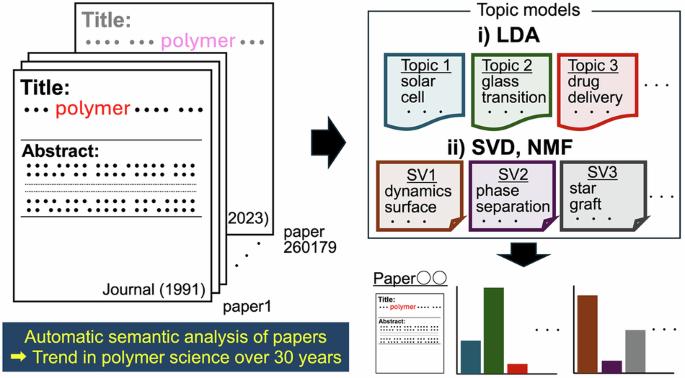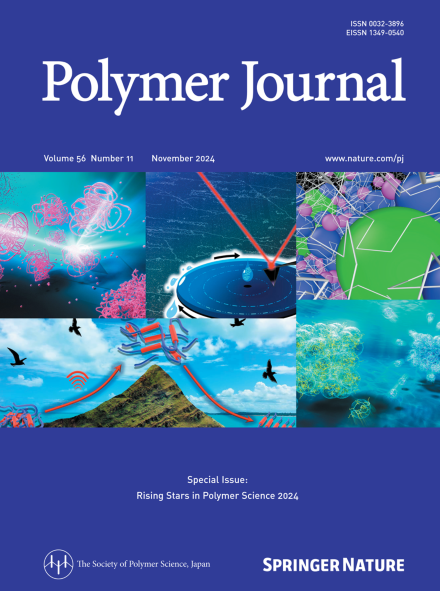Natural language processing-based topic models for analyzing trends in polymer science
IF 2.7
4区 化学
Q3 POLYMER SCIENCE
引用次数: 0
Abstract
Polymer science has enhanced human life for more than 100 years, and numerous scientific papers have been published in this field. Although reviewing overall trends is valuable, manually processing such a large volume of information is difficult. In this study, we captured trends in polymer science by performing an automated analysis of papers using topic-modeling techniques grounded in natural language processing (NLP). We analyzed the titles and abstracts of papers that contained the keyword “polymer” in their titles and were published from 1991–2023, applying latent Dirichlet allocation (LDA), singular value decomposition (SVD), and nonnegative matrix factorization (NMF) as topic models. This research showed that LDA, SVD, and NMF can capture trends across multiple fields over the past three decades. Accordingly, NLP-based topic models are promising tools for automatically extracting useful information from papers and other textual data in polymer science. Polymer science has enhanced human life for more than 100 years, and numerous scientific papers have been published in this field. In this study, we captured trends in polymer science by performing an automated analysis of the titles and abstracts of papers that contained the keyword “polymer” using topic-modeling techniques grounded in natural language processing (NLP). NLP-based topic models are promising tools for automatically extracting useful information from papers and other textual data in polymer science.

基于自然语言处理的聚合物科学趋势分析主题模型
100多年来,聚合物科学一直在改善人类的生活,在这一领域发表了大量的科学论文。尽管审查总体趋势是有价值的,但手动处理如此大量的信息是困难的。在这项研究中,我们通过使用基于自然语言处理(NLP)的主题建模技术对论文进行自动分析,捕捉了聚合物科学的趋势。我们采用潜狄利let分配(LDA)、奇异值分解(SVD)和非负矩阵分解(NMF)作为主题模型,对1991-2023年间发表的包含“聚合物”关键词的论文的标题和摘要进行了分析。该研究表明,LDA、SVD和NMF可以捕获过去30年多个领域的趋势。因此,基于nlp的主题模型是聚合物科学中自动从论文和其他文本数据中提取有用信息的有前途的工具。100多年来,聚合物科学一直在改善人类的生活,在这一领域发表了大量的科学论文。在这项研究中,我们使用基于自然语言处理(NLP)的主题建模技术,对包含关键词“聚合物”的论文的标题和摘要进行自动分析,从而捕捉到了聚合物科学的趋势。基于nlp的主题模型是一种很有前途的工具,可以从聚合物科学的论文和其他文本数据中自动提取有用的信息。
本文章由计算机程序翻译,如有差异,请以英文原文为准。
求助全文
约1分钟内获得全文
求助全文
来源期刊

Polymer Journal
化学-高分子科学
CiteScore
5.60
自引率
7.10%
发文量
131
审稿时长
2.5 months
期刊介绍:
Polymer Journal promotes research from all aspects of polymer science from anywhere in the world and aims to provide an integrated platform for scientific communication that assists the advancement of polymer science and related fields. The journal publishes Original Articles, Notes, Short Communications and Reviews.
Subject areas and topics of particular interest within the journal''s scope include, but are not limited to, those listed below:
Polymer synthesis and reactions
Polymer structures
Physical properties of polymers
Polymer surface and interfaces
Functional polymers
Supramolecular polymers
Self-assembled materials
Biopolymers and bio-related polymer materials
Polymer engineering.
 求助内容:
求助内容: 应助结果提醒方式:
应助结果提醒方式:


